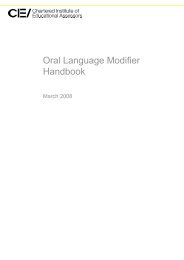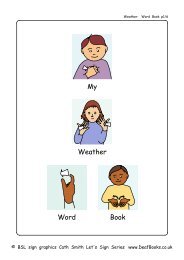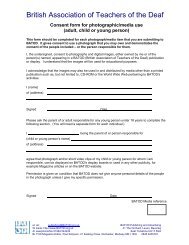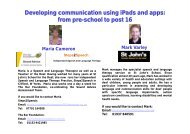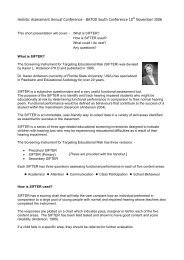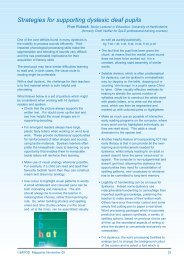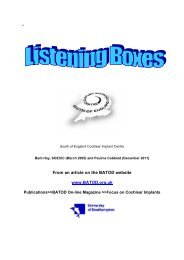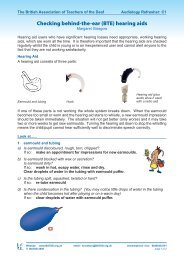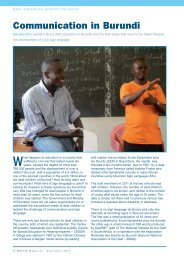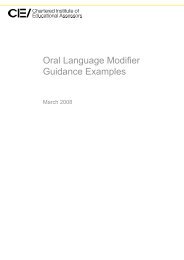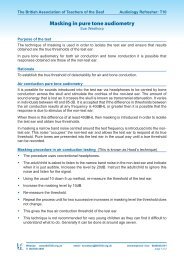Goal fulfilment in school for the deaf and hearing impaired - batod
Goal fulfilment in school for the deaf and hearing impaired - batod
Goal fulfilment in school for the deaf and hearing impaired - batod
- No tags were found...
You also want an ePaper? Increase the reach of your titles
YUMPU automatically turns print PDFs into web optimized ePapers that Google loves.
Just less than one-third of <strong>the</strong> parents are oftenor always actively <strong>in</strong>volved <strong>in</strong> <strong>the</strong> <strong>school</strong>’sparental activities <strong>and</strong> a slightly larger proportionof <strong>the</strong> pupils are often or always active <strong>in</strong> <strong>the</strong><strong>school</strong>’s pupil democracy groups. Two-thirds of<strong>the</strong> teachers th<strong>in</strong>k that <strong>the</strong> pupils can often oralways pursue <strong>the</strong>ir <strong>in</strong>terests <strong>in</strong>dependently at<strong>school</strong>.Of <strong>the</strong> 1,305 teachers who responded to thisquestion, 98% of <strong>the</strong>m th<strong>in</strong>k that <strong>the</strong> pupilsoften or always feel secure at <strong>school</strong>. This is<strong>the</strong> same figure as that with which <strong>the</strong> parentsresponded. There is no significant differencebetween <strong>the</strong> types of <strong>school</strong>. This is a higherfigure than was reported by special <strong>school</strong>s <strong>in</strong>2003 (Utredn<strong>in</strong>gs<strong>in</strong>stitutet H<strong>and</strong>u 2003).About <strong>school</strong>sMost parents usually choose a <strong>school</strong> which isclosest to home. In <strong>the</strong> National Agency <strong>for</strong>Education’s survey of 2003, 80% of parents gavethis response. On account of circumstances,parents of hear<strong>in</strong>g <strong>impaired</strong> <strong>and</strong> <strong>deaf</strong> childrenare, however, impelled to choose a <strong>school</strong> on <strong>the</strong>basis of o<strong>the</strong>r criteria than parents of childrenwith normal hear<strong>in</strong>g (see tables 25 <strong>and</strong> 26).Many parents of pupils with moderate to severehear<strong>in</strong>g impairments select a <strong>school</strong> on <strong>the</strong>basis of access to hear<strong>in</strong>g technology. Manymake <strong>the</strong> choice on a recommendation from<strong>the</strong> audiological health care service. For parentsof <strong>deaf</strong> pupils, sign language <strong>and</strong> bil<strong>in</strong>gualismare <strong>the</strong> most important factors <strong>in</strong> <strong>the</strong> choice of<strong>school</strong>.Many parents say that <strong>the</strong>y are pleased or verypleased with <strong>the</strong>ir choice. Parents of pupils atclasses <strong>for</strong> <strong>the</strong> hear<strong>in</strong>g <strong>impaired</strong> are <strong>the</strong> mostsatisfied – 88%. This result corresponds well witho<strong>the</strong>r surveys (Hässleholms kommun 2005). Asregards special <strong>school</strong>s, 78% of <strong>the</strong> parents arepleased or very pleased.Mobility between <strong>the</strong> types of <strong>school</strong>s is relativelysmall even if a certa<strong>in</strong> mobility always does exist(Thoutenhoofd 2006). On <strong>the</strong> basis of 1,660parent responses, it is apparent that <strong>the</strong> greatestmobility is among pupils mov<strong>in</strong>g between<strong>school</strong>s <strong>for</strong> hear<strong>in</strong>g <strong>impaired</strong> <strong>and</strong> ord<strong>in</strong>arycompulsory <strong>school</strong>s. But a large proportionof pupils choose to go directly from ord<strong>in</strong>arycompulsory <strong>school</strong>s to special <strong>school</strong>s.Even if <strong>the</strong>re are quite natural reasons <strong>for</strong> <strong>the</strong>semoves, never<strong>the</strong>less <strong>the</strong>re are complications<strong>for</strong> pupils, <strong>for</strong> example <strong>in</strong> <strong>the</strong> adaptation ofpremises <strong>and</strong> different communication methods(Wrennstad Gyllenram 2006).There are discussions with<strong>in</strong> <strong>school</strong>s <strong>for</strong> <strong>the</strong>hear<strong>in</strong>g <strong>impaired</strong> <strong>and</strong> special <strong>school</strong>s as towhe<strong>the</strong>r pupils from compulsory <strong>school</strong>s oftenchange to <strong>the</strong>se types of <strong>school</strong>s because ofencounter<strong>in</strong>g significant difficulties at a previoustype of <strong>school</strong>. Pupils with difficulties thatdevelop gradually <strong>in</strong> a non-adapted environment<strong>and</strong> that, <strong>in</strong> addition, are perhaps discovered late,are not easy to rehabilitate <strong>in</strong> <strong>the</strong> space of a fewyears <strong>in</strong> <strong>school</strong>s <strong>for</strong> hear<strong>in</strong>g <strong>impaired</strong> or special<strong>school</strong>s. Table 27 shows, on <strong>the</strong> basis of ourquestionnaire responses, pupil mobility between<strong>the</strong> different types of <strong>school</strong>s. Freedom of choiceis considerable <strong>in</strong> Sweden, as regards types of<strong>school</strong>s <strong>for</strong> <strong>deaf</strong> <strong>and</strong> hear<strong>in</strong>g <strong>impaired</strong> pupils, <strong>in</strong>comparison with many o<strong>the</strong>r countries.In response to <strong>the</strong> question whe<strong>the</strong>r <strong>the</strong> childhad repeated a year 7 , an average of about 10%of <strong>the</strong> parents said that <strong>the</strong>ir child had. In thiscase <strong>the</strong>re was no difference between <strong>the</strong> types of<strong>school</strong>s.It goes almost without say<strong>in</strong>g that <strong>the</strong> differenttypes of <strong>school</strong>s should provide equal educationirrespective of hear<strong>in</strong>g impairment. If <strong>the</strong> typesof <strong>school</strong>s are looked at from an historicalperspective, special <strong>school</strong>s have dist<strong>in</strong>guished<strong>the</strong>mselves by only us<strong>in</strong>g sign language, while7If parents apply, School head have a possibility to decide a retention year <strong>for</strong> a pupil. (See Compulsory School Ord<strong>in</strong>ance(1994:1194))<strong>Goal</strong> <strong>fulfilment</strong> <strong>in</strong> <strong>school</strong> <strong>for</strong> <strong>the</strong> <strong>deaf</strong> <strong>and</strong> hear<strong>in</strong>g <strong>impaired</strong>53



